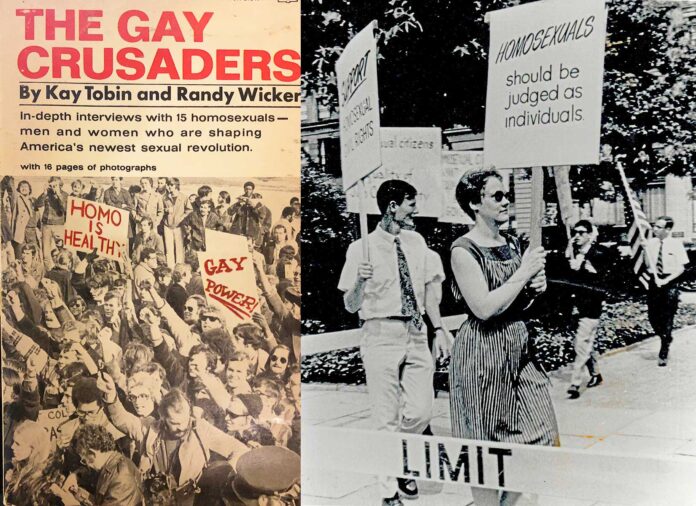
If you’ve seen photographs of the 1965-69 Independence Hall Demonstrations, where gay men and lesbians marched demanding equality, chances are that picture was taken by Kay Lahusen. Lahusen was a prolific activist along with her partner, Barbara Gittings. She photographed many of the early LGBT activists during their marches and events, including Gittings, Frank Kameny, Marty Robinson and Isabel Miller.
Lahusen also photographed gay and lesbian couples in moments of tenderness, something that was not often seen at the time. Her photograph of Lilli Vincenz was the first full-face photo of a lesbian on the cover of the influential lesbian publication “The Ladder,” where she also worked.
“I tried to put wonderful women on the covers,” Lahusen told PGN in 2019. “That was very important, because before then we only had drawings on covers.”
For a time in the ’80s, Lahusen even had ads in PGN when she worked as a real estate agent. In 2007, her and Gittings’ papers were donated to the New York Public Library. Several of her photographs were on display at an NYPL exhibit during the Stonewall 50th anniversary. She also wrote the book “The Gay Crusaders,” published in 1972, which featured interviews with 15 LGBTQ activists of the time.
Oftentimes, the people behind the scenes or behind the camera don’t get the same recognition and publicity as those front and center. But Lahusen’s work has helped get vital information to the LGBTQ community and the general public. Her photographs of protests help us remember the beginnings of the push for LGBTQ civil rights. Her photographs of people and couples help us remember the joy and love our community has. Her work with Barbara Gittings helped get LGBTQ books in libraries.
Beyond her work in LGBTQ activism, Lahusen was a kind human being who truly understood the importance of civil rights. In an interview with Mark Segal celebrating her 90th birthday, Lahusen gave some advice for young LGBTQ people interested in making change.
“Join the movement,” Lahusen said. “It can be frustrating and irritating, and it can be fun. Gay rights isn’t all marching in parades. There’s a lot of drudgery behind the scenes. A lot of trying to draft various articles and statements, a lot of calling on politicians. Sometimes it is hard work. Trying to roll back prejudice and discrimination is a job, but I still say, you can have a lot of fun if you do it.”
In her introduction to “The Gay Crusaders” Lahusen wrote: “The crusaders written about here were chosen for their records of accomplishment in advancing the gay cause, and for the diversity of their contributions and viewpoints. They come from all walks of life. They are all action-oriented persons at work in the movement itself. They are all strong-minded individuals taking firm positions in the face of society’s hostility toward homosexuality. Some of them have been in the gay movement long enough to tell of the secrecy and repression that afflicted the movement years ago, and to trace the beginnings of militancy. Others are relatively new to the cause and tell primarily of the bold strides toward liberation taken by today’s dynamic organizations. And finally, all, of course, are gay and proud.”
Lahusen herself was among those gay crusaders, and she should be celebrated and remembered as one.
